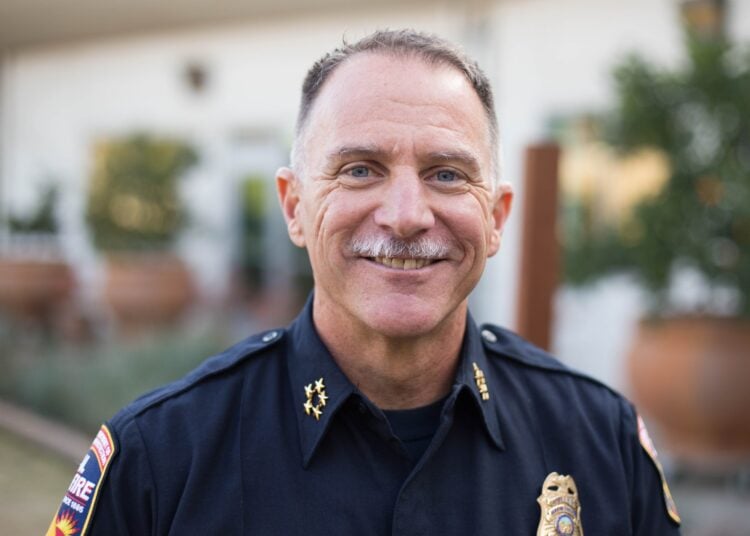Interview with the State of California’s Department of Forestry and Fire Protection (CAL FIRE) Chief Ken Pimlott, 22 March 2016, on the first day of the Aerial Fire Fighting Conference, Sacramento, CA.
Andrew Drwiega: Ken, thanks for talking to us on the first day of the Aerial Fire Fighting (AFF) conference in Sacramento, California. I would like to start by getting your opinion on the most productive advances in aerial firefighting in recent years.
Ken Pimlott: There are two that stand out: technological progress and the tactical use of aircraft. There has been technological change and refinement in the delivery of fire retardant. Over the last 10 years the biggest single technological change which is shaping the future of firefighting is the increasing implementation of jet aircraft into the aerial firefighting arsenal.
In 2006, CAL FIRE pioneered the concept of using the DC-10 [in a demonstration then fighting fires later in the year] and was considered at the time ‘out of the box’ in terms of conventional firefighting and was met with a lot of skepticism from within the organization and the firefighting community in general. But we had some forward thinking operations chiefs and aviators who proved it could work. Over several years they looked at delivery mechanisms as well as refining how to use it tactically.
Andrew Drwiega: What is the current situation regarding the planned replacement of your 12 Huey UH-1H helicopters. I understand a re-bid will take place due to some vendor misinterpretation regarding the written requirement?
Ken Pimlott: The helicopter replacement decision is public and we had three vendors who put forward a total of four bids. We have never gone to the open market for an aviation platform as we have been a huge user of the Federal Excess Property program which covers equipment/aircraft that originally belonged to the Department of Defense [DoD].
Once acquired by the U.S. Forest Service it is loaned to State agencies for firefighting. This path has served the State of California well in the past. The UH-1s were retrofitted and rebuilt for our purposes, but we now have a responsibility to upgrade our capability. It has been an emotional decision for firefighters. When you are on the ground, the signature sound of the Huey has always been wonderful to hear.
The bids that were submitted ranged between $104-160 million. We are looking for 12 aircraft eventually but the first bid is for nine helicopters. We are working closely with the State’s procurement experts and the Department of Finance on next steps to ensure that we select the helicopter that will meet all our mission requirements.
We will also be working with the legislature on securing funding for the procurement. We hope to have the first helicopter out within the next year or two but that depends on the successful vendor and their capacity to deliver the helicopters.
We want to fly the new helicopter type to understand how it performs in different conditions. It is tough to speculate but we will have to wait until the successful bidder is identified. If we have to wait a bit longer for the right helicopter then we will.
Right now we own the Hueys and have our own fire pilots, but we leverage the maintenance expertise from DynCorp International. Having a vendor supplying maintenance support has been phenomenal. We go out every three or four years to the market and rebid, although DynCorp International has been very successful and just won another term for two years with three optional years.
Andrew Drwiega: What are your thoughts regarding the value of Unmanned Aerial Vehicles (UAVs) to aerial wildfire operations?
Ken Pimlott: We are making the transition to their use and have a working group looking at remotely piloted aircraft. We conducted a trial in 2013 with a [California National Guard] Predator. We literally had to go to the Secretary of State for Defense for permission as we had to address civil liberty issues and be very clear about the missions we intended to perform. But it was a good proof of concept, especially as it could loiter over the fire for 15 hours at a time.
Andrew Drwiega: So what prime missions did you identify for UAV operations?
Ken Pimlott: Certainly first would be monitoring the status of the fire and keeping track of where the hotspots are. Inversions and smoke columns make it very difficult to see normally but the UAVs’ equipment helped with that. It allowed us to make decisions tactically about where to place resources to combat the most active part of the fire.
It also helps with fire fighter safety, identifying and continually monitoring resources on the ground. We will have an automated vehicle location system from July after the Governor’s budget [which will be similar to the military ‘blue force tracker’]. So once that combines with long endurance eyes in the sky, you have a great resource. With UAVs, we have a responsibility knowing there such technology out there. We need to look to see how best to utilize it.
Andrew Drwiega: Finally, what are your thoughts on the AFF conference and exhibition?
Ken Pimlott: This is the cutting edge of the aerial firefighting industry and community. As aviation is a relatively small community, it is about the private and public sectors coming together to provide innovation. There is no better venue to bring all these experts together.
We have also had more interaction over the last several years with international representatives including those from Greece, Canada and Australia. Nobody is isolated anymore - we are learning from everybody as nobody has all the answers.
Draft Executive Order Signals Major Changes for US Wildland Firefighting Operations
A draft executive order (EO) from the Trump administration is poised to significantly reshape the way wildland firefighting is conducted...






